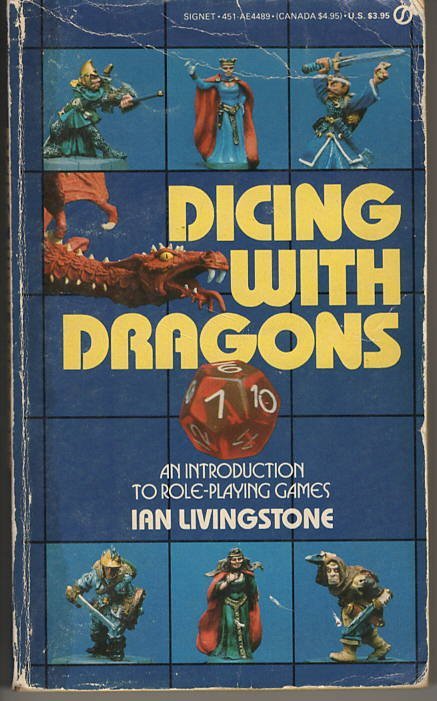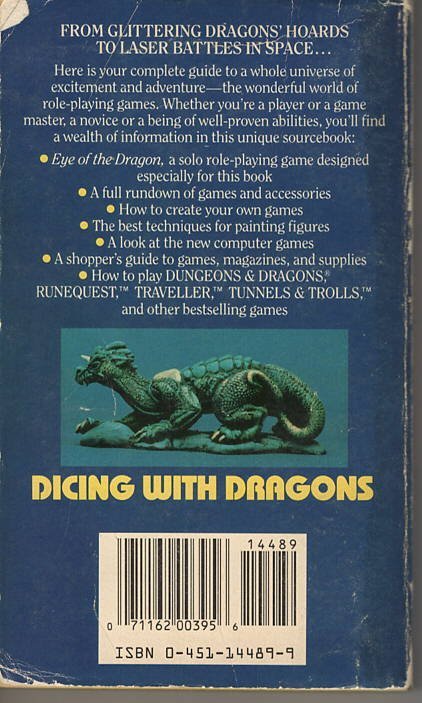
It's perhaps about time I talked about this book, written by Ian Livingstone with illustrations by Russ Nicholson, which was published originally in 1982, but didn't cross my path until '86 or '87. It also might have been redundant, given that I was already familiar with role-playing games, but this was bought during a period of my life when information was a lot harder to find than it is now, and I was really intrigued by the fact that here was an entire book on the topic.
The book itself is very outdated now, but back in the 80s offering coverage of role-playing games (RPGs), it was considerably more informative than most other media available at the time. It offered a bigger picture of the hobby than I was exposed to by going to a Stars and Stripes Bookstore (that and the base Exchange overseas was the only place I used to see role-playing games for sale before making it back to the States).
The book opens with an introduction to RPGs with a narrative depicting a scene between characters as though it were a work of fantasy fiction. The first chapter then goes on to discuss how RPGs work and conveying the same scene as an exchange between players at the table.
In its zeal to educate readers about role-plaing games, this book actually came with a chapter which contains a solo funhouse-style dungeon adventure. I've only been through it the once, and still retain the map I made from it. The adventure itself is fairly linear, but this probably reasonable considering how short it is (the solo adventure spans a single chapter, including the rules for playing the adventure). I admit it; I had fun with it back in the day.
The book then offers brief essays on:
- Dungeons & Dragons
- RuneQuest
- Traveller
- Tunnels & Trolls
…concluding with a listing and a paragraph each for many other RPGs, from Aftermath, to Call of Cthulhu, to Gamma World, to Star Frontiers, to Stormbringer, to Villains and Vigilantes. The listing is hardly complete, even for 1982, but it was an eye-opening one for me back in the day, who had previously been mostly exposed to TSR products.
The next chapter goes into accessories for most of the games listed in Chapter 3. These can include supplements like rules expansions, playing aids, dungeon modules (published scenarios), maps, and background materials.
Chapter five talks about miniatures, something I was always fascinated by but didn't actually get until much later. Reading about them provided me with at least a small amount of background to this aspect of the hobby. This chapter covers buying and painting miniatures, the kinds of paints which can be used, and as much of the process as can be covered in a strictly black and white, mostly textual format. I don't mean to make this sound as limited as all that, but the only color photos of the process are on the cover, and those are completed minis.
The next chapter is about refereeing your own material. This always seemed natural to me, since I never had a lot of money for buying off-the-shelf adventures to begin with, and the majority of what I was able to collect came to me second-hand.
Chapter seven ("Computer Games") is almost quaint in light of the modern scale and scope of console and computer gaming. I'd argue it offers some small historical perspective, especially considering that most of the systems being discussed have made comebacks in vintage computing circles (due, it must be noted, to the fact that all of these platforms could be used to play games).
The chapter on LARPing (Live Action Role-Playing) always fascinated me, but this is an activity which I've yet to engage in. I mean, when I was in high school I may have dabbled by creating armor and weapons out of cardboard and painting them, but it was hardly anything as sophisticated as this chapter describes, and as I lived on an island with a very small population at the time, I had almost no one else to help me play in this fashion. Maybe someday.
The next chapter talks about how to start. You'd think this would be somewhat obvious at this point, but it is sometimes good to have a summary.
The first appendix lists the games and the addresses of their publishers—really outdated information at this point. The second appendix covers magazines, similarly outdated. The last appendix covers figures and who produces them. Needless to say, this was handy in the early 1980s, but is less so now.
And that's the book. As a companion and guide to the hobby when I first acquired it, I considered it essential enough to hang on to through nearly four decades and two continents, often shelving it next to my Lone Wolf books. As a result of owning and reading this book, I was able to order (from the Mountain Mage catalog) my copy of Tunnels & Trolls, a game I've had plenty of fun with, but without this book, would not ever know it existed.
Livingstone, Ian. Dicing with Dragons. Signet/New American Library. 1986.

